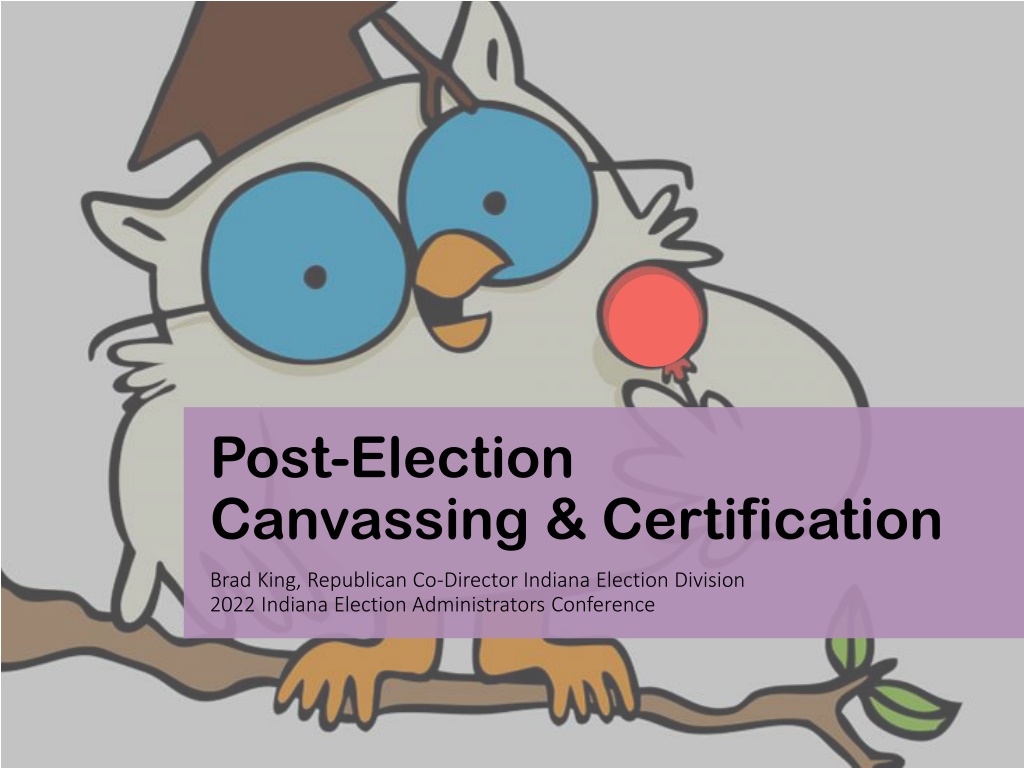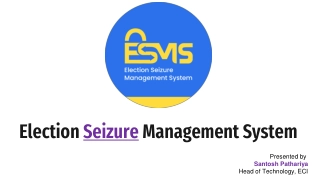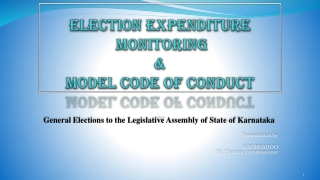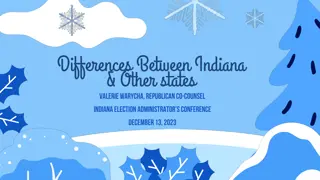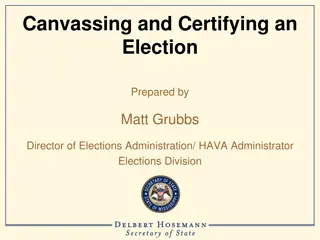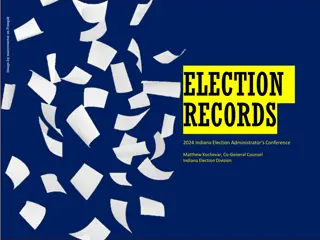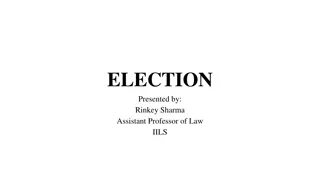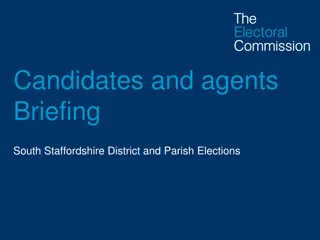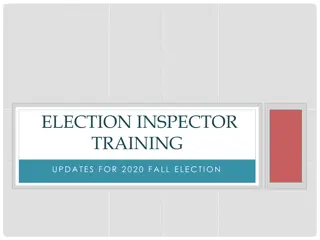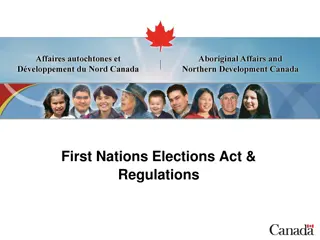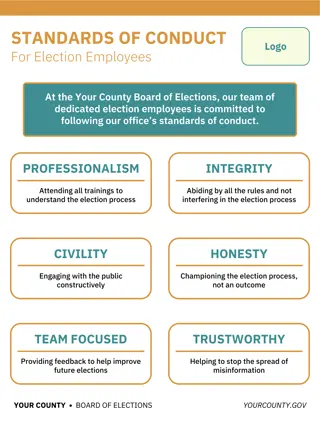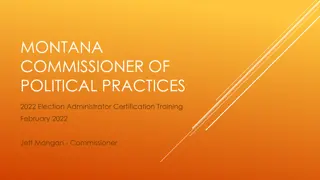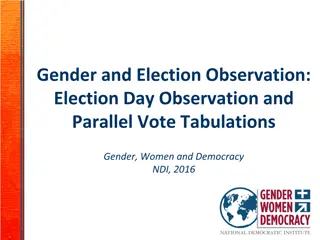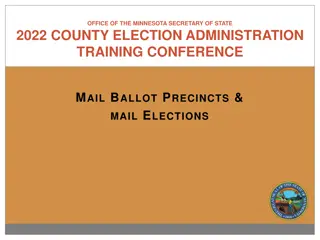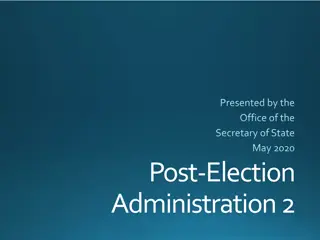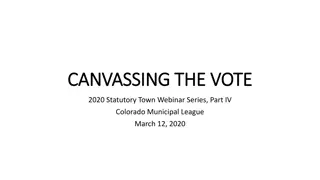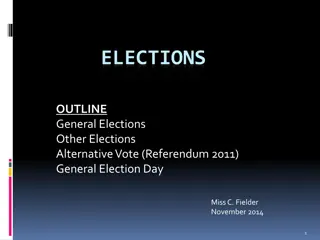Post-Election Canvassing & Certification Procedures in Indiana Elections
In Indiana, post-election canvassing and certification procedures are crucial in ensuring accurate election results. After the polls close, precinct election boards must tabulate results and seal necessary documents before delivering them to the county election board. This process involves tabulating election results using different systems like DRE machines and optical scan technology. Strict guidelines are followed to verify vote totals, print necessary documents, and return materials promptly. Compliance with detailed procedures is essential for maintaining transparency and integrity in the election process.
- Indiana Elections
- Post-Election Canvassing
- Certification Procedures
- DRE Systems
- Optical Scan Technology
Uploaded on Sep 20, 2024 | 0 Views
Download Presentation

Please find below an Image/Link to download the presentation.
The content on the website is provided AS IS for your information and personal use only. It may not be sold, licensed, or shared on other websites without obtaining consent from the author. Download presentation by click this link. If you encounter any issues during the download, it is possible that the publisher has removed the file from their server.
E N D
Presentation Transcript
Post-Election Canvassing & Certification Brad King, Republican Co-Director Indiana Election Division 2022 Indiana Election Administrators Conference
The polls have now closed but we re just starting canvassing The precinct election board must tabulate election results of precinct as soon as polls closes on 6 pm on Election Day and all voters (including those in line at 6 pm) have voted At polling locations where multiple precincts are located all voters in each precinct must complete voting and leave before poll workers can begin to tabulate ballots The precinct election board (inspector and 2 judges) must complete PRE-17 (primary) & PRE-11 for (general) and seal in PRE-15 envelope with any tally paper from ballot tabulators PRE-15 envelope must be delivered with the other precinct materials by the inspector and judge of the other major party
Tabulating Election Results - DRE For locations that use DRE systems follow system instructions to tabulate ballots and printout precinct vote totals for each candidate and public question Must print out at least 1 vote total printout (tally paper) for county election board Print extra copies of printout upon request of each appointed watcher and news media Some voting system vendors design tally paper to be signed by precinct election board Complete certificate form and seal form & tally paper in PRE- 15 and return to county election board IC 3-11-14-30 | IC 3-11-14-32 | IC 3-12-3.5-4
Tabulating Election Results Optical Scan Count ballots in ballot box & confirm if number matches number of voters who signed pollbook Print tally paper from tabulator if ballots were scanned through the tabulator as voter deposited ballot into ballot box If ballots were not sent through tabulator, then the precinct election board must do so immediately after the ballots in the ballot box are counted Make requested copies of tally paper for watchers and news media Complete certificates and seal in PRE-15 Inspector and judge of other major party returns results to CEB with other precinct materials IC 3-12-3-1 | IC 3-12-3-2 | IC 3-12-3.5-4
Tabulating Results at Vote Centers The tabulation procedures apply to vote center locations At each vote center tally reports must be printed for each precinct. If vote center uses ballot cards, then ballot cards must be organized and separated by precinct EXCEPT in Marion County. IC 3-11-18.1-4
Laws for Counting Ballots The general principles for how ballots are to be counted and tabulated are coded into tabulator software, but BE AWARE of laws that apply if a manual review of a ballot is required The primary factor to consider when counting a ballot is the intent of the voter If the voter s intent can be determined for who they vote for then the vote shall be counted for that candidate or on a public question Some laws provide that if a specific event happens, then the ballot cannot be counted. Some issues can be caught on Election Day before the voter s ballot is deposited in the ballot box. In those cases, a voter may spoil their first ballot and get a new ballot to cast. IC 3-12-1-1
Rules for Counting Ballots Cont. A ballot cannot be counted if either or both of the bipartisan poll clerk initials are missing EXCEPT for ABSENTEE BALLOTS, the ballot can be counted if the precinct is involved in a recount or contest after the election The whole ballot is void if a distinguishing mark is found on the ballot A distinguishing mark is a mark or mutilation made on the ballot with the intent to enable another to determine who cast the ballot This includes the voter s names, initials, a number, or a symbol A voting mark is not a distinguishing mark The whole ballot is void if the voter does an extrinsic act (folding a paper into the ballot) with the intent to enable another to determine who cast the ballot Ensure marks on the ballot do not void the ballot unless the intent is established the marks were made to determine who cast the ballot IC 3-12-1-2 | IC 3-12-1-3 | IC 3-12-1-10 | IC 3-12-1-12
Voting Marks A voting mark made according to the instructions on the ballot must be counted for the candidate or answer to the public question next to the voting mark No votes can be counted on a ballot if the voter votes for more candidates than can be elected (Overvote) DRE systems & OpScan Ballots with BMD prevent a voter from being able to do this Tabulators for OpScan Ballots completed by pen or pencil are designed to alert voter if an overvote is detected Allows vote to ask for ballot to be spoiled and get a new ballot to complete IC 3-12-1-5 | IC 3-12-1-6 | IC 3-12-1-7
Straight Ticket Laws If voting mark is made for a straight party ticket option then vote applies to each candidate nominated by that political party on the ballot But straight ticket voting does not apply vote to any candidate for at- large, vote for more than 1 offices on the ballot Straight ticket does not apply vote for school board or other nonpartisan offices or public questions. A voting mark made according to the instructions on the ballot must be counted for the candidate or answer to the public question next to the voting mark IC 3-12-1-7
Straight Ticket Laws If voter votes a straight ticket ballot for a political party and votes for an individual candidate who is not a nominee of the party The individual vote for that candidate is counted and the straight party vote is not for the office If a voter votes for more than 1 straight ticket option then no votes can be counted for any office where a political party nominates a candidate for the office Public questions, school board office, nonpartisan judicial office, and judicial retention question can still be counted IC 3-12-1-7
The Former Candidate For various reasons, a candidate can become a former candidate just before election day and remains on the ballot Votes for a former candidate may not be counted for a successor candidate who fills the ballot vacancy A vote may be counted for a successor candidate if the candidate s straight party ticket is selected Only applies to single member offices like circuit court clerk If the ballot vacancies happens in time where the CEB reprinted the ballot with No Candidate or Candidate Deceased in the place of the former candidate THEN, votes for this statement count as vote for successor candidate who fills the ballot vacancy IC 3-5-2-26.1; 3-12-1-14 | IC 3-12-1-15 | IC 3-12-1-16
Canvassing CEB begins canvassing the vote to certify the election results on election night after the polls close CEB responsible for: Careful examination and comparison of all certificates, poll lists and tally sheets Careful examination and comparison of all certificates, poll lists and tally sheets Have results entered in EMS to help determine results Canvassing must be performed in public pursuant to IC 5-14- 1.5; however The room where the canvassing is conducted may be organized in a way to prevent observers from physically handling any election materials or interfering with the canvassing process IC 3-12-4-1 | IC 3-12-4-6
Canvassing CEB should gather and inspect records from all vote sources: tally cards, ballot cards, or paper ballots tally print-outs from the individual voting system units & EMS printouts absentee ballots tally of voter signatures at check-in (if paper poll lists are utilized) or printouts from electronic poll books used for the precinct at voter check-in DRE VVPAT print-outs CEB should enter this information into a spreadsheet and check the information for accuracy. The number of rejected and spoiled ballots (if any) should be tallied, recorded, and placed into the spreadsheet if one is used.
Canvassing CEB may employ clerical assistants, as needed, to assist in the tabulation of the vote. Clerical assistants must meet the same qualifications as the person serving as a precinct election official Must be equally represented by the Democratic and Republican political parties of the state However, CEB may, by unanimous vote of its entire membership, also employ a college student registered to vote in the county to assist the board in a nonpartisan manner IC 3-12-4-4 | IC 3-6-6-7
Canvassing & Write-Ins CEB in counties where OpScan ballots are use are required to appoint the bi-partisan write-in teams to examine and count write-in votes The Democratic and Republican county chair each name one member of the team Teams follow rules in IC 3-12-1-1.7 to determine if write-in vote can be counted Only votes for declared write-in candidates for an office can be counted Write in vote must be written in space on ballot for write-in candidate declared for that office Even if write-in is misspelled or abbreviated if voter s intent to cast vote for declared candidate can be determine then vote applies to that candidate IC 3-12-1-1.7| IC 3-12-4-4
Reporting Results On Election Day, counties report unofficial results NO results can be released before 6 PM (local prevailing time), after the polls close This includes ABS results from the central count! Many counties will report results to: Media Political party leaders Candidates Public through county s website (if available) CEB have until noon (Indianapolis time) on the second Monday following Election Day to certify final election results. IC 3-12-5-1
Reporting To State ENR Site CEB required to begin entering unofficial results into SVRS to populate the state s ENR site (indianavoters.com/electionresults): Beginning at 8 pm (local prevailing time) on election day; and Update at least every 2 hours until midnight CEB must resume entering unofficial election results at 9 am, local prevailing time, the day following Election Day; and Update at least once an hour until all the unofficial results are published. You can publish results on ENR page beginning at 6 pm if you have results to report IC 3-12-4-6.3
Transferring Results Some counties will move election results from EMS system to upload into SVRS by transferring results onto a USB drive first CEB & staff can only use USB drive that contains anti- malware protection features and as been approved by VSTOP Contact VSTOP to inquire if your USB drive has been approved for use IC 3-12-3-12.7 | IC 3-12-4-6.5
Do Not Publish Before 6 PM! Election results are not public information until the polls close, even if the county s absentee ballots are tabulated before the polls close CEB members and staff must not release results before the polls close to any person since a violation of that law is a Level 6 felony. As results are published on election day it is also helpful to remind the public those results are unofficial until the CEB certifies the final results to IED IC 3-14-4-10
Certifying Final Results Election results are considered unofficial until the CEB completes a canvass of election results and tallies all ballots Including eligible provisional ballots and late-arriving overseas voter ballots Not later than noon (Indianapolis time), the second Monday after a primary, general, or municipal election, the circuit court clerk must prepare a statement certifying the final results from the election A county must use SVRS to certify the final results of the elections conducted in the county SVRS is set up so the results you enter populate into the correct certification forms The CEB-10, CEB-11, CEB-12, and CEB-13 forms IC 3-12-5-1.5
Election Report (CEB-9) Clerk must file a County Election Report (CEB-9) Provides a snapshot of: the total voters including absentee and provisional information to report to EAC cost of the election allows for the reporting of significant issues wait times for voters at designated hours during election day Precinct election results are to be attached to the CEB-9 filed through SVRS Results can be manually uploaded and attached to CEB-9 file In most counties, precinct election results may be uploaded to SVRS after mapping the voting system s precinct level results text file to SVRS Deadline to finalize the CEB-9 in SVRS is noon,14 days after a primary, general, or municipal election IC 3-6-5-17 | IC 3-6-5-17.5
Bordering Multiple Counties Some school board, city, or town office election districts can include parts of more than one county In this case only, a circuit court clerk certifies election results to another county For these districts each clerk certifies the results to the clerk of the county in which the largest part of the population of the election district is located That clerk & CEB conduct the canvass for that cross-county office and certify the final results This procedure also applies to a local public question on the ballot in more than one (1) county IC 3-12-5-2
Reporting Primary Election Results Reporting final primary election results are done in the same way as general election results (CEB-23 & CEB-24 reports) The candidate of a political party who receives the highest number of votes for an office in a primary is the nominee of that party for that office CEB must declare the candidate receiving the highest number of votes for each party office such as precinct committeeman or state convention delegate to be elected Not later than noon (prevailing local time) on the second Monday following the primary election in even-numbered years, the circuit court clerk must provide IED with a list of: all names and addresses of candidates nominated in the primary; and all names and addresses of state convention delegates elected in the primary along with the congressional district in which the delegate resides Results of precinct committeemen are not required to be reported to IED No requirement to report the names and addresses of those elected IC 3-8-7-1 | IC 3-8-7-5
Certificate of Elections Those elected to state, judicial, and certain local offices receive a commission from the governor or a certificate from the Secretary of State (Example: a Certificate of Election is issued by Secretary of State to elected state legislators) Commissions and Certificates are issued after IED canvasses results reporting by counties and provide report to be certified by SOS Those elected to other local offices or party offices can receive certificate of elections from the clerk Clerk is not required to provide certificate of election unless requested by elected candidate Certificate of election can be produced from SVRS CEB-7, CEB-8, CEB-16, CEB-18, CEB-21, CEB-32, and CEB-33 IC 3-12-5-2
Recounts & Contests There are no automatic recount or contest actions in Indiana Specific individuals may petition the courts (local office) or state recount commission (statewide, state legislative, or federal offices) to request a recount A recount reviews the election materials and ballots already cast in an election and determines which candidate received the highest number of votes A contest action may result in a new election being called for the specific race or contest IC 3-12-6 | IC 3-12-11
Recounts & Contests for Local Candidates A candidate requesting a recount must file a verified petition for recount in the circuit or superior court of the county no later than noon, prevailing local time, fourteen (14) days after the election If the candidate does not do so, the candidate s political county chairman may file a recount petition no later than noon, prevailing local time, seventeen (17) days after the election Filings require specific information be included and a filing fee & bond is required IC 3-12-6-2 | IC 3-12-6-2.5
Recounts & Contests for Local Candidates Recount is conducted by a three-member commission appointed by judge assigned to oversee the recount case A contest is a court proceeding where the contest petitioner presents arguments and facts to a judge that: The candidate was elected is ineligible to assume office; or A mistake or act occur during the election that makes it impossible to determine who received the highest number of votes IC 3-12-6-2 | IC 3-12-6-2.5
Election Records During Recounts & Contests During a recount, a judge or the state recount commission may order that law enforcement impound the election materials until the recount concludes If a recount or contest is filed for an election in your county then all the election materials must remain sealed until the recount or contest action concludes. State level impoundment may impact canvassing of elections for local office in the county. IC 3-12-6 | IC 3-12-11 | IC 3-10-1-31.1
A TIE! Whenever a tie vote occurs at a primary election, a CANDIDATE VACANCY results The resulting vacancy is filled through the early ballot vacancy process under IC 3-13-1 A tie in a general election for a federal, state (other than governor and lieutenant governor), or legislative office requires a special election to break the tie. Whenever a circuit court clerk receives certification of a tie vote has occurred, the clerk shall immediately send written notice of the tie vote to the fiscal body of the affected political subdivision Fiscal body is defined by IC 36-1-2-6 A fiscal body must resolve the tie by electing a person to fill the office not later than December 31 following the election If office is an at-large multi-member office, then fiscal body must elect enough candidates to fill the seats that have tie IC 3-12-9 | IC 3-13-1-17
Thanks! IC 3-12-9 | IC 3-13-1-17
